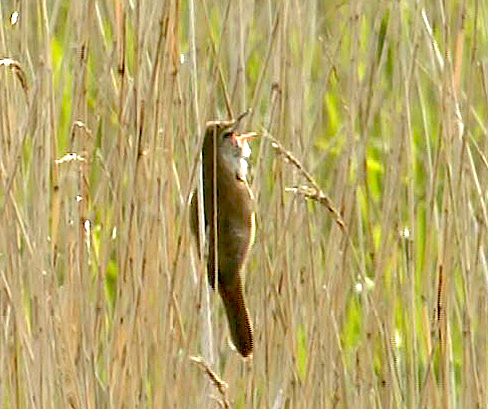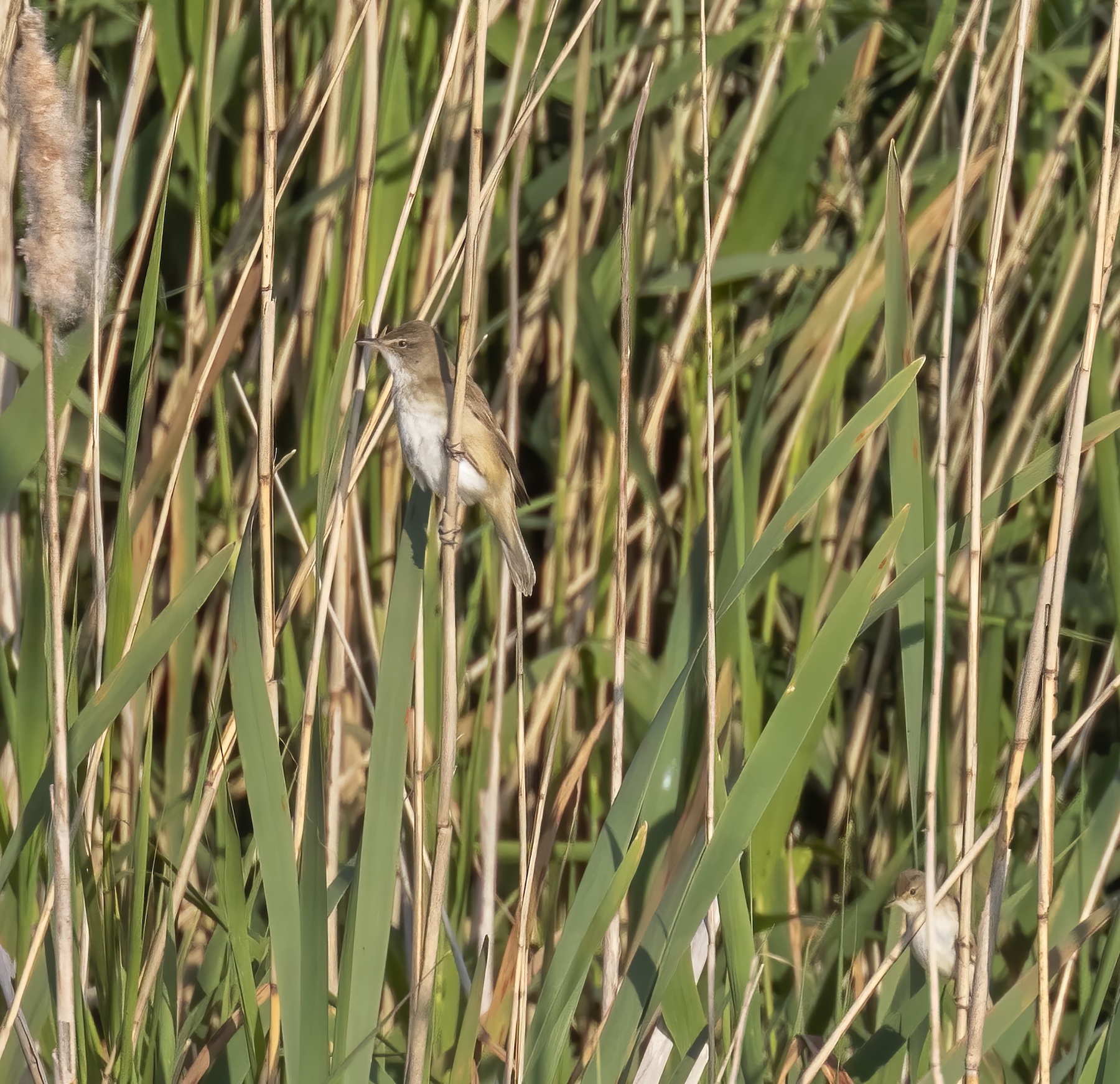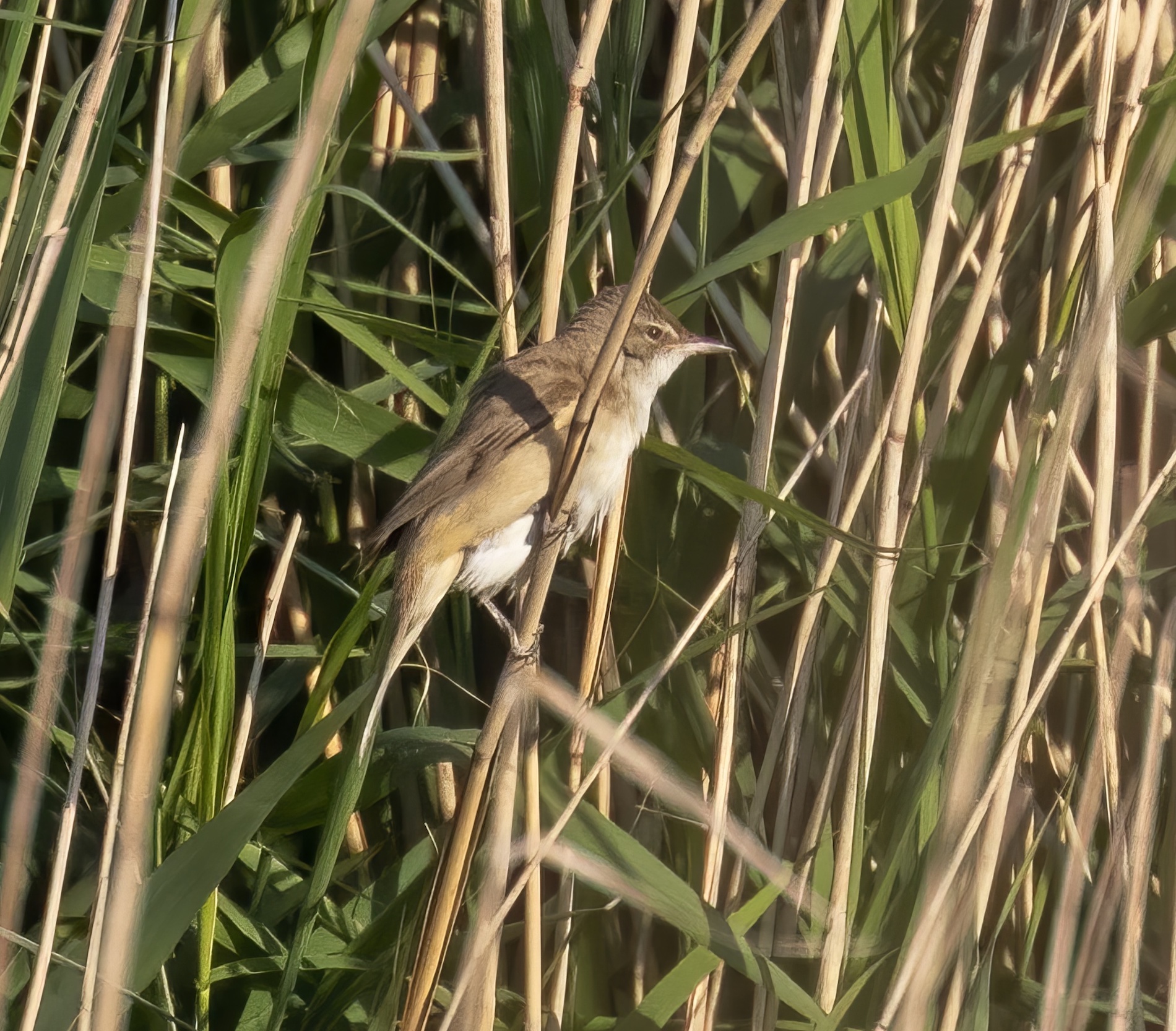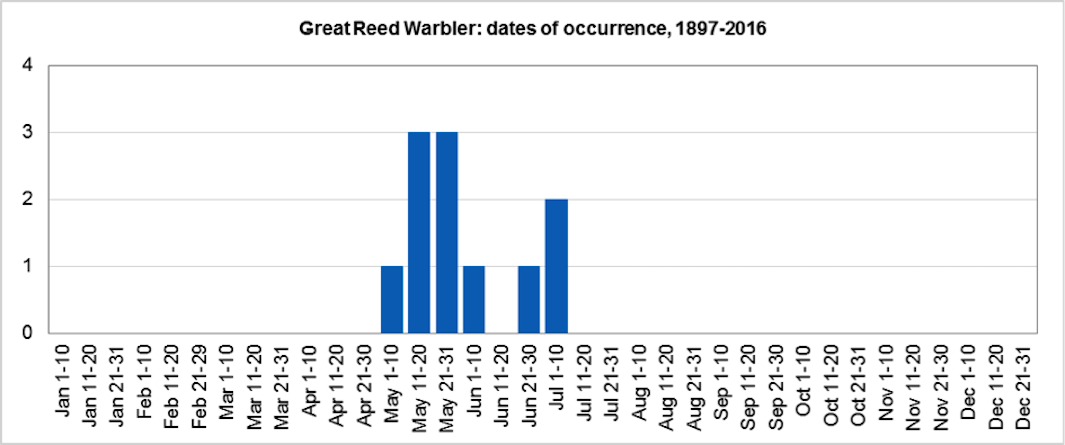Great Reed Warbler Acrocephalus arundinaceus



Great Reed Warblers: left, Chapel Pits June 2000 (Roy Harvey); centre & right Water's Edge CP June 5th 2016 (Graham Catley). Centre photo with Reed Warbler, A. scirpaceus,
showing the considerable difference in size.
Rare vagrant. The first Lincolnshire record was of one heard singing for several weeks in July 1897 in a reedbed near Tetney Lock. This record was thought unconvincing by Smith & Cornwallis (1955) but has generally been acceptable to other authors, including L&A. The bird was heard by J. Cordeaux on 28th July 1897 (Cordeaux 1899) and their description of it's song was as follows:
"...we were greatly surprised to hear what could only be the noisy rattling song of this very rare wanderer to England, coming from the reed-beds in Madam's Creek (the old bed of the Haven) at Tetney Lock. I and, given the species’ distinctive song and the typical date, we see no reason to exclude it.was certain of the species, having heard it abroad, and remembering the song so well expressed by the words, "kar-ra-kar-ra-kee-kee"."
Given the species’ distinctive song, Cordeaux's description of it, and the typical date, we see no reason to exclude it.
The next record was of one trapped and ringed at Huttoft on 3rd May 1969 by Keith Atkin and John Cooper, and nine more have occurred since then. It is striking that all but one are known to have been males, and that most were singing in reedbeds along the coast or along the Humber. The arrival dates have predominantly been in spring, with eight found during 3rd May-5th June, and the other three a little later in the summer, during 24th June-6th July (chart below; assumes the 1897 bird arrived at the start of July, given that it was said to be present for several weeks).
| Site | First date | Last date | Count | Notes |
| Tetney Lock | July 1897 | - | 1 | Singing male for most of July, heard by several people including Cordeaux |
| Huttoft | 03/05/1969 | - | 1 | Trapped |
| Chapel Pit | 23/05/1976 | 30/06/1976 | 1 | Singing male |
| Wolla Bank Pit | 11/07/1976 | - | 1 | Presumed same singing male as at Chapel Pit |
| Huttoft Pit | 26/07/1976 | 28/07/1976 | 1 | Presumed same singing male as at Chapel Pit and Wolla Bank Pit |
| Burton GP | 06/07/1979 | 22/07/1979 | 1 | Singing male |
| North Cotes Point | 20/05/1980 | - | 1 | Singing male |
| Waith Beck, Waithe | 19/05/1990 | - | 1 | Singing male |
| Chapel Pit | 29/05/2000 | 13/06/2000 | 1 | Singing male |
| Deeping Lakes LNR | 16/05/2001 | 22/05/2001 | 1 | Singing male |
| Far Ings NR, Barton upon Humber | 24/06/2006 | - | 1 | Singing male |
| Gibraltar Point NNR | 23/05/2014 | - | 1 | Male trapped, sang brieflyafter release but not seen subsequently |
| Waters Edge CP, Barton upon Humber | 05/06/2016 | 06/06/2016 | 1 | Singing male |

Finder’s report: Great Reed Warbler at Huttoft Bank, May 3rd, 1969: first 'modern' record.
by J. F. Cooper and K. Atkin.
Note: this account is taken from the original Rarities Committee submission. The RC report noted that 1969 produced eight records, in contrast to 1968 which was the first year with no records since these Rarities Reports began in 1958. It was the largest annual total in this period.
Circumstances
The weather on May 3rd began with sea mist and poor visibility. While trapping in the sand dunes at Huttoft Bank I flushed a large, heavy warbler out of some low willow bushes. It flew about 12 yd. before flopping down heavily into some more bushes. It appeared similar to a young Song Thrush. Fortunately, the bird had landed in front of one of my mist-nets and I was then able to trap it. When the bird was in the net, I was immediately able to recognise it as a Great Reed Warbler. After ringing it, I took it to show KA who was ringing nearby, and we took the following description.
Description - in the hand
Upperparts – crown, back, rump and uppertail coverts warm brown (similar to Reed Warbler) with the crown being slightly darker. The tail appeared slightly paler although it was worn and the tips abraded, which gave the appearance of white spots on the tips of the feathers. The wings were brown whilst the bastard wing was dark brown with the middle feathers having a broad buff outer edge. The primaries, secondaries and tertials were brown with whitish abraded tips and buffish outer fringes to the feathers. The coverts were warm brown.
Underparts – chin and throat were creamy white. The rest of the underparts with the exception of the belly were orange-buff becoming richer on the flanks. The underwing and tail coverts were similar whilst the belly was a lot paler. Ear coverts and lores were dark brown, giving the appearance of a darkish stripe through the eye. There was a pale creamy superciliary extending from the bill and ending above the ear coverts, where it was more conspicuous. There was a white half ring above and below the eye.
Bare parts – eyes pale brown. Upper mandible blackish-brown, lower mandible pinkish becoming darker nearer the tip. Gape pinkish, inside of mouth orange-red. Legs pale pinkish-grey, feet grey with the soles yellowish-straw. It had three black nasal bristles on either side of the base of the bill.
Biometrics – wing length 96 mm., emarginated 3rd and slightly on 4th, 3rd primary longest; tail 78 mm, rounded 8 mm. Bill 23 mm; tarsus 28.5 mm; weight at 10.00 hr. 25 gm.
1st primary minute and thin, pointed; 8 mm. shorter than primary coverts.
2nd primary – 3 mm. shorter than wing point.
4th primary – 3.5 mm. shorter than wing point.
5th primary – 6 mm. shorter than wing point.
6th primary – 9 mm. shorter than wing point.
7th primary – 13.5 mm. shorter than wing point.
8th primary – 15 mm. shorter than wing point.
9th primary – 18.5 mm shorter than wing point.
10th primary – 21.5 mm. shorter than wing point.
Notch on the inner web of 2nd primary was 16 mm. from tip and equal to the 9th primary.
The bird was distinguished from Clamorous Reed Warbler A. stentoreus by having longer wings and a different wing formula, i.e., 2nd primary in Clamorous Reed Warbler is 4-6 mm. shorter than the wing point and falls between 5th and 6th. It also has a long 5th primary, i.e., 1-2 mm. shorter than wing point and also the other primaries are longer in Clamorous Reed. Also, the notch on the inner web of the 2nd primary falls well below the secondaries in Clamorous Reed. These measurements were taken from ‘Identification guide for ringers. The genera Cettia, Locustella, Acrocephalus and Hippolais’ by K. Williamson. It was distinguished from Thick-billed Warbler by superciliary stripe, longer bill, longer wings and minute first primary.
Description - in the field
I then released the bird at Huttoft Bank and on release it called twice, a similar note to a Reed Warbler but louder and more drawn out. It then landed on some reeds in a ditch, and I obtained some excellent views of it for approximately a quarter of an hour. The bird sat about a third of the way down a reed where it raised its crown giving the appearance of a steep forehead. Both the supercilium and large bill were very noticeable in the field. It then flew along the ditch where the white tips to the tail, caused by abrasion, were conspicuous. The tail itself did not appear unduly rounded. A thorough search was made for it in the afternoon but it could not be found.
References
Cordeaux, J. (1899). A List of the British Birds belonging to the Humber District. R.H. Porter, London.
Smith, A.E. and Cornwallis, R.K. (1955). The Birds of Lincolnshire. Lincolnshire Naturalists’ Union, Lincoln.
(Account prepared October 2017; updated with reference to the new Birds of Lincolnshire (2021) November 2022)

